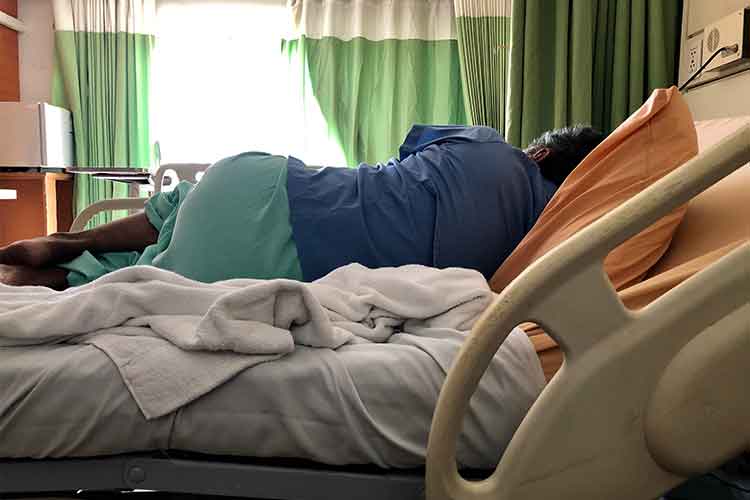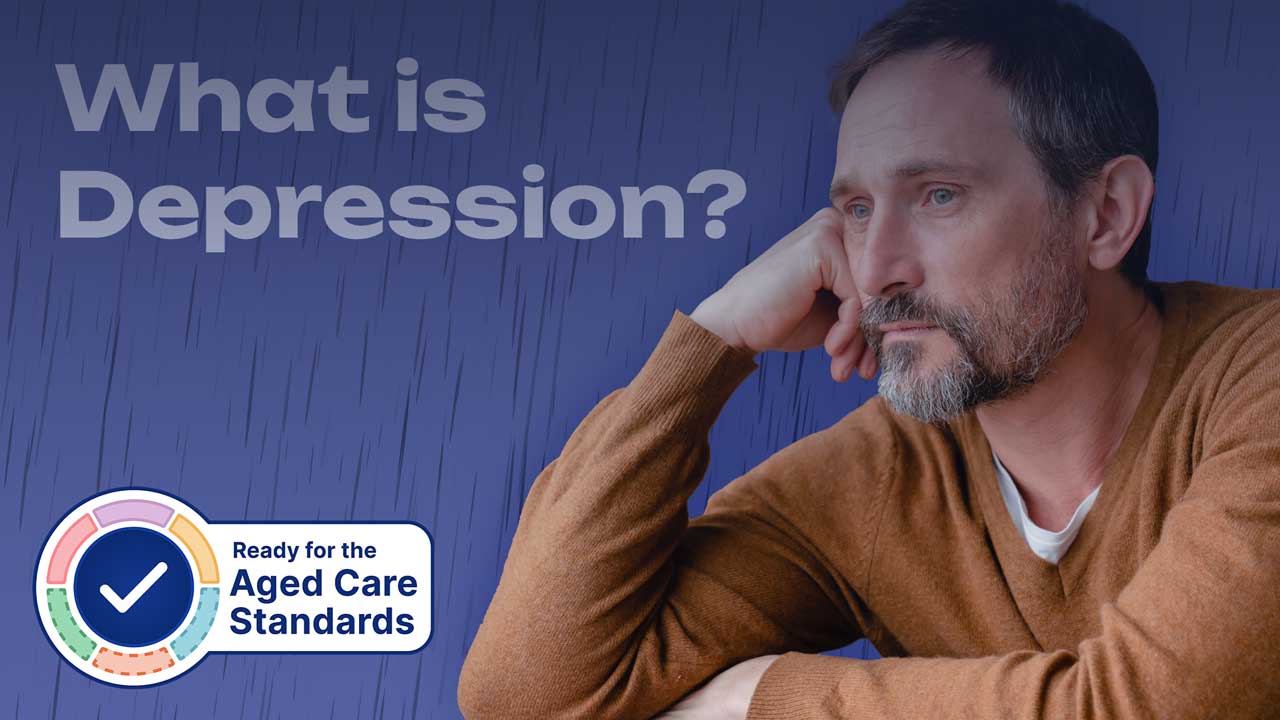Content warning: Please be aware that this Article contains references to self-harm and suicide.
You may be alarmed to learn approximately 1.5 million Australians are currently living with depression (Beyond Blue 2024a).
And, with one in seven Australians expected to experience depression at least once in their lifetime (Beyond Blue 2024a), it is practically guaranteed that someone in your care is living with this mental illness.
Unfortunately, particularly in older populations, stigma remains around seeking help for mental illnesses. Furthermore, rates of depression among people living in residential aged care are at least 15% higher than in older people living in the community (Beyond Blue 2024a).

What is Depression?
It’s human nature to feel down in the dumps on occasion. Depression, however, is a diagnosable medical condition that presents as feelings of intense sadness, negativity and low mood, lasting for a long period of time (APS 2018).
A characteristic of depression is that the route of the sadness is not always easy to pinpoint. Tough times can trigger a bout, but sometimes there is no obvious reason why a person may be depressed (APS 2018).
Depression is often accompanied by a range of other physical and psychological symptoms, often affecting everyday living (SANE 2023). If your low mood has become so intense that it is affecting your relationships or your work, or you are neglecting activities you once found to be simple or enjoyable, this could be a sign of depression, and help should be sought.
Depression Under the Strengthened Aged Care Quality Standards
Standard 5: Clinical Care - Outcome 5.5: Clinical Safety under the strengthened Aged Care Quality Standards (Action 5.5.6) requires aged care providers to optimise older people’s mental health by:
- Promoting mental health and wellbeing
- Recognising and addressing signs of deterioration in mental health
- Providing support to older people who are experiencing distress or symptoms of mental illness (e.g. self-harm and suicidal thoughts) in order to reduce risks to their physical and psychological health.
(ACQSC 2024)
Types of Depression
The term ‘depression’ is generally used to refer to ‘major depression’. However, there are several types of conditions that can be classified under the ‘depression’ umbrella.
1. Major Depression / Clinical Depression
Major depression, clinical depression or major depressive disorder is the most common form of depression and what most people mean when they think of ‘depression’. The characteristics of major depression include a low mood that is felt most days of the week and that lasts for at least two weeks (ReachOut Australia 2024a).
2. Melancholia
Melancholia is a term for a very severe depression that presents with more physical symptoms. Major characteristics of melancholia include moving slower than normal and suffering from a complete loss of pleasure in almost everything (Healthdirect 2022).
3. Dysthymia
Dysthymia, also known as persistent depressive disorder, refers to a generally less severe form of major depression with longer-lasting symptoms (ReachOut Australia 2024a).
4. Psychotic Depression
Psychotic depression is severe and is characteristically accompanied by a loss of touch with reality and episodes of psychosis, hallucinations and/or delusions (ReachOut Australia 2024a).
5. Perinatal Depression
Perinatal depression refers to depression experienced from conception, during (antenatal depression) and after pregnancy and childbirth (postnatal depression). Perinatal depression is more than a passing ‘baby blues’ and can affect both mothers and fathers (NSW Heath 2021).
6. Seasonal Affective Disorder
Often overlooked as a simple case of the ‘winter blues’, seasonal affective disorder (SAD) is a mood disorder that presents in a seasonal pattern. Most commonly felt in the cooler months, SAD can also occur during spring and summer (Healthdirect 2024).
Depression, Delirium and Dementia
Read: Assessing Depression in Dementia with the Cornell Scale
It’s important to note the overlap that often exists between depression, delirium and dementia. High rates of delirium and depression are reported in people with dementia, and conversely, dementia and depression are further risk factors for developing delirium (Health.vic 2015). You should familiarise yourself with the differences between the three conditions, as misdiagnosis is common, particularly in older people.

Causes of Depression
There are a number of factors that may contribute to depression, such as:
- Irregular mood regulation in the brain
- Genetics
- Exposure to stressful life events (such as trauma or loss)
- Effects of medication
- Personality traits
- Other health problems
- Other mental health conditions (such as bipolar disorders)
- Environmental stressors.
(Beyond Blue 2024b; SANE Australia 2023)
Who Can Get Depression?
Though depression can be developed by anybody at any stage of life, there are some populations who are at a greater risk than others, including:
- People living in residential care
- Females are more likely than males to experience depression and anxiety (however, males are far less likely to report or seek help for mental health conditions).
- People who live in remote and regional areas are at a greater risk of depression and suicide
- Pregnant or new parents
- Aboriginal and Torres Strait Islander people are nearly three times more likely to be psychologically distressed than non-Indigenous Australians
- LGBTIQ+ Australians are far more likely to be psychologically distressed than non-LGBTIQ+ Australians.
(Beyond Blue 2024a)
Signs and Symptoms of Depression
Signs and symptoms of depression can vary from person to person and will range from mild to very severe. One or many of the following may be felt by someone experiencing depression:
- Feeling ‘down’, sad or close to tears
- Feeling numb, overwhelmed, irritable or frustrated
- Loss of interest or pleasure in usually enjoyable activities
- Not going out/withdrawing from social circles
- Relying on alcohol, sedatives or other self-medication
- Difficulty concentrating
- Negative thoughts and talk
- Fatigue and lack of energy
- Feeling worthless or guilty
- Thoughts of self-harm or suicide
- Feeling hopeless/helpless
- Difficulty remembering things
- Difficulty sleeping, sleeping more than usual or other disturbances to sleep patterns
- Eating more
- Loss of appetite
- Weight loss or gain
- Headaches
- Churning stomach, ‘knots’.
(ReachOut Australia 2024b; Beyond Blue 2024c; SANE 2023)
If any of the above symptoms are severe, last for two weeks or more and begin to affect other aspects of a person’s life, professional help should be sought (Black Dog Institute 2022).

Treating Depression
It is important to remember that depression is treatable, just like any other illness.
A treatment plan should be person-centred and developed in collaboration with the patient to best tailor options to suit their personal circumstances (ReachOut Australia 2024b).
Treatment options may include:
- Psychological interventions such as cognitive behaviour therapy (CBT), interpersonal therapy (IPT), family therapy, mindfulness-based cognitive therapy (MBCT), other forms of psychotherapy
- Pharmacological interventions such as antidepressant medications
- Lifestyle changes, such as regular exercise, eating a well-balanced and varied diet, maintaining a healthy sleep routine, practising relaxation and meditative activities, and seeking support from others.
(Black Dog Institute 2023; ReachOut Australia 2024b)
Timely interventions are key. Each person may respond differently to treatments, and finding the right treatment may take time. Therefore, it is important that the patient is supported through this process (ReachOut Australia 2024b).
Taking Action
If you suspect someone in your care is experiencing depression and has been displaying any of the signs and symptoms listed above, they should be referred to a general practitioner, mental health nurse, psychologist or psychiatrist.
If you or a person in your care expresses they are feeling suicidal, seek immediate help.
Immediate Support Services
24-hour support services and counselling are available, including:
- Lifeline: 13 11 14 www.lifeline.org.au
- Beyond Blue: 1300 22 4636 www.beyondblue.org.au
Test Your Knowledge
Question 1 of 3
Which one of the following is NOT a possible sign of depression?
Topics
Further your knowledge
 Free
Free Free
Free Free
FreeReferences
- Aged Care Quality and Safety Commission 2024, Standard 5: Clinical Care, Australian Government, viewed 23 May 2024, https://www.health.gov.au/resources/publications/strengthened-aged-care-quality-standards-august-2025?language=en/environment
- Australian Psychological Society 2018, Depression, APS, viewed 23 May 2024, https://psychology.org.au/for-the-public/psychology-topics/depression
- Beyond Blue 2024b, Causes of Depression, Beyond Blue, viewed 23 May 2024, https://www.beyondblue.org.au/mental-health/depression/causes-of-depression
- Beyond Blue 2024c, Signs and Symptoms of Depression, Beyond Blue, viewed 23 May 2024, https://www.beyondblue.org.au/mental-health/depression/signs-and-symptoms
- Beyond Blue 2024a, Statistics, Beyond Blue, viewed 22 May 2024, https://www.beyondblue.org.au/mental-health/statistics
- Black Dog Institute 2022, Symptoms of Depression, Black Dog Institute, viewed 23 May 2024, https://www.blackdoginstitute.org.au/wp-content/uploads/2022/06/Symptoms-of-depression.pdf?sfvrsn=2
- Black Dog Institute 2023, Treatments for Depression, Black Dog Institute, viewed 23 May 2024, https://www.blackdoginstitute.org.au/resources-support/depression/treatment/
- Health.vic 2015, Differential Diagnosis - Depression, Delirium and Dementia, Victoria State Government, viewed 23 May 2024, https://www.health.vic.gov.au/patient-care/differential-diagnosis-depression-delirium-and-dementia
- Healthdirect 2022, Melancholia (Melancholic Depression), Australian Government, viewed 23 May 2024, https://www.healthdirect.gov.au/melancholia
- Healthdirect 2024, Seasonal Affective Disorder (SAD), Australian Government, viewed 23 May 2024, https://www.healthdirect.gov.au/seasonal-affective-disorder
- NSW Health 2021, Signs and Symptoms of Perinatal Mental Health Issues, New South Wales Government, viewed 23 May 2024, https://www.health.nsw.gov.au/mentalhealth/services/parents/dads/Pages/signs.aspx
- ReachOut Australia 2024b, Everything You Need to Know About Depression, ReachOut Australia, viewed 23 May 2024, https://au.reachout.com/mental-health-issues/depression/depression
- ReachOut Australia 2024a, Types of Depression, ReachOut Australia, viewed 23 May 2024, https://au.reachout.com/mental-health-issues/depression/types-of-depression
- SANE 2023, Depression, SANE, viewed 23 May 2024, https://www.sane.org/information-and-resources/facts-and-guides/depression
 New
New 
